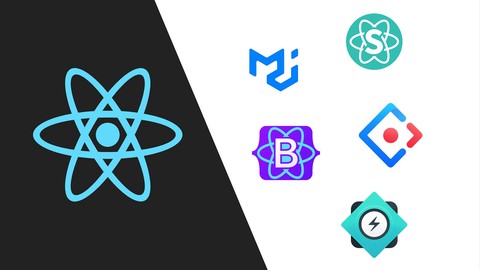
React Component Library From Scratch using Tailwind CSS
React Component Library From Scratch using Tailwind CSS, available at $54.99, has an average rating of 3.67, with 33 lectures, based on 3 reviews, and has 58 subscribers.
You will learn about This course is about building our own component library from scratch using the world's first utility framework, Tailwind CSS. Button: A clickable element that is used to trigger an action or submit a form. Input Field: A form element that allows users to input data, such as text or numbers. Tailwind CSSPage Header: A section at the top of a page that typically includes a title and navigational links. Spinner: An animated icon used to indicate that a process is in progress and the user should wait. Tabs: A navigation element that allows users to switch between different content sections within a page. Autocomplete: A form element that provides suggestions as the user types, often used for searching or selecting options. Table: A grid of data organized into rows and columns. Modal: A temporary overlay or popup window that displays additional information or requires user action. Navbar: A navigation element that typically appears at the top of a page and includes links to other sections of the site. Select Field: A form element that allows users to choose from a list of options typically displayed as a dropdown menu. This course is ideal for individuals who are This course is ideal for developers who want to learn how to build components from scratch using Tailwind CSS. Whether you are a beginner or an experienced developer, you will gain valuable skills and knowledge that you can apply to your own projects. It is particularly useful for This course is ideal for developers who want to learn how to build components from scratch using Tailwind CSS. Whether you are a beginner or an experienced developer, you will gain valuable skills and knowledge that you can apply to your own projects.
Enroll now: React Component Library From Scratch using Tailwind CSS
Summary
Title: React Component Library From Scratch using Tailwind CSS
Price: $54.99
Average Rating: 3.67
Number of Lectures: 33
Number of Published Lectures: 33
Number of Curriculum Items: 33
Number of Published Curriculum Objects: 33
Original Price: $19.99
Quality Status: approved
Status: Live
What You Will Learn
- This course is about building our own component library from scratch using the world's first utility framework, Tailwind CSS.
- Button: A clickable element that is used to trigger an action or submit a form.
- Input Field: A form element that allows users to input data, such as text or numbers.
- Tailwind CSSPage Header: A section at the top of a page that typically includes a title and navigational links.
- Spinner: An animated icon used to indicate that a process is in progress and the user should wait.
- Tabs: A navigation element that allows users to switch between different content sections within a page.
- Autocomplete: A form element that provides suggestions as the user types, often used for searching or selecting options.
- Table: A grid of data organized into rows and columns.
- Modal: A temporary overlay or popup window that displays additional information or requires user action.
- Navbar: A navigation element that typically appears at the top of a page and includes links to other sections of the site.
- Select Field: A form element that allows users to choose from a list of options typically displayed as a dropdown menu.
Who Should Attend
- This course is ideal for developers who want to learn how to build components from scratch using Tailwind CSS. Whether you are a beginner or an experienced developer, you will gain valuable skills and knowledge that you can apply to your own projects.
Target Audiences
- This course is ideal for developers who want to learn how to build components from scratch using Tailwind CSS. Whether you are a beginner or an experienced developer, you will gain valuable skills and knowledge that you can apply to your own projects.
Hello and welcome to our course on building a component library from scratch using Tailwind CSS!
In this course, you will learn how to create a variety of components such as buttons, input fields, page headers, spinners, tabs, autocomplete fields, tables, modals, navbars, and select fields. By the end of this course, you will have the skills and knowledge needed to build your own custom component library from scratch.
We will be using Tailwind CSS, the world’s first utility framework, to build our components. You will learn how to use Tailwind’s utility classes to style your components and make them responsive to different screen sizes.
Here’s a breakdown of the components we will be building:
-
Button: A clickable element that is used to trigger an action or submit a form.
-
Input Field: A form element that allows users to input data, such as text or numbers.
-
Page Header: A section at the top of a page that typically includes a title and navigational links.
-
Spinner: An animated icon used to indicate that a process is in progress and the user should wait.
-
Tabs: A navigation element that allows users to switch between different content sections within a page.
-
Autocomplete: A form element that provides suggestions as the user types, often used for searching or selecting options.
-
Table: A grid of data organized into rows and columns.
-
Modal: A temporary overlay or popup window that displays additional information or requires user action.
-
Navbar: A navigation element that typically appears at the top of a page and includes links to other sections of the site.
-
Select Field: A form element that allows users to choose from a list of options typically displayed as a dropdown menu.
This course is ideal for developers who want to learn how to build components from scratch using Tailwind CSS. Whether you are a beginner or an experienced developer, you will gain valuable skills and knowledge that you can apply to your own projects.
Building a component library from scratch can be a challenging task, but it can also be a rewarding experience. By creating a set of reusable components, developers can save time and improve the consistency and quality of their code. In addition, component libraries can be shared with other developers, making it easier to collaborate on projects and maintain a consistent design language across different applications.
When building a component library, it is important to consider factors such as accessibility, usability, and responsiveness. Components should be designed with a focus on user experience and should be tested across a range of devices and screen sizes to ensure they work properly in different contexts.
Overall, building a component library using Tailwind CSS can be a great way to improve the efficiency and quality of your development process. By creating reusable components that can be easily integrated into different projects, you can save time and improve the consistency and quality of your code.
Course Curriculum
Chapter 1: Introduction
Lecture 1: Promo
Lecture 2: React App Setup
Lecture 3: Installing Libraries
Lecture 4: List Components in Homepage
Chapter 2: Button
Lecture 1: Basic Button
Lecture 2: Disabled and Onclick Functionality
Lecture 3: Custom Background Color
Lecture 4: Custom Text Color
Chapter 3: Input
Lecture 1: Input – 1
Lecture 2: Input – 2
Chapter 4: Page Header
Lecture 1: Page Header – 1
Lecture 2: Page Header – 2
Chapter 5: Spinner
Lecture 1: Spinner – 1
Lecture 2: Spinner – 2
Chapter 6: Tabs
Lecture 1: Tabs – 1
Lecture 2: Tabs – 2
Lecture 3: Tabs – 3
Lecture 4: Tabs – 4
Chapter 7: Modal
Lecture 1: Modal – 1
Lecture 2: Modal – 2
Lecture 3: Modal – 3
Chapter 8: Select
Lecture 1: Select – 1
Lecture 2: Select – 2
Lecture 3: Select – 3
Lecture 4: Select – 4
Chapter 9: Autocomplete
Lecture 1: Autocomplete – 1
Lecture 2: Autocomplete – 2
Chapter 10: Table
Lecture 1: Table – 1
Lecture 2: Table – 2
Lecture 3: Table – 3
Chapter 11: Card
Lecture 1: Card – 1
Lecture 2: Card – 2
Chapter 12: Deployment
Lecture 1: Deploy to Netlify
Instructors
-
K.Sathyaprakash Reddy
Full Stack Developer
Rating Distribution
- 1 stars: 1 votes
- 2 stars: 0 votes
- 3 stars: 0 votes
- 4 stars: 0 votes
- 5 stars: 2 votes
Frequently Asked Questions
How long do I have access to the course materials?
You can view and review the lecture materials indefinitely, like an on-demand channel.
Can I take my courses with me wherever I go?
Definitely! If you have an internet connection, courses on Udemy are available on any device at any time. If you don’t have an internet connection, some instructors also let their students download course lectures. That’s up to the instructor though, so make sure you get on their good side!
You may also like
- Top 10 Financial Technology Courses to Learn in December 2024
- Top 10 Agile Methodologies Courses to Learn in December 2024
- Top 10 Project Management Courses to Learn in December 2024
- Top 10 Leadership Skills Courses to Learn in December 2024
- Top 10 Public Speaking Courses to Learn in December 2024
- Top 10 Affiliate Marketing Courses to Learn in December 2024
- Top 10 Email Marketing Courses to Learn in December 2024
- Top 10 Social Media Management Courses to Learn in December 2024
- Top 10 SEO Optimization Courses to Learn in December 2024
- Top 10 Content Creation Courses to Learn in December 2024
- Top 10 Game Development Courses to Learn in December 2024
- Top 10 Software Testing Courses to Learn in December 2024
- Top 10 Big Data Courses to Learn in December 2024
- Top 10 Internet Of Things Courses to Learn in December 2024
- Top 10 Quantum Computing Courses to Learn in December 2024
- Top 10 Cloud Computing Courses to Learn in December 2024
- Top 10 3d Modeling Courses to Learn in December 2024
- Top 10 Mobile App Development Courses to Learn in December 2024
- Top 10 Graphic Design Courses to Learn in December 2024
- Top 10 Videography Courses to Learn in December 2024






















